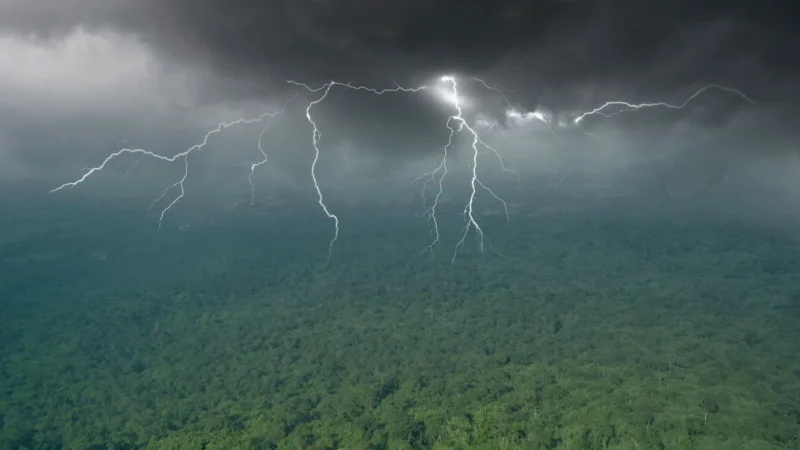Fast Facts
-
Increased Tree Mortality: Tropical forests are experiencing higher rates of tree death due to an array of factors, including intensified thunderstorms, which have been largely overlooked in research and climate models.
-
Significant Threat: Thunderstorms are now identified as a major cause of tree mortality, potentially accounting for 30-60% of tree deaths, particularly affecting mature trees and jeopardizing carbon storage.
-
Challenges in Detection: Monitoring storms and their impacts on forests is difficult due to their localized damage, necessitating innovative research methods like the Gigante project, which employs drone technology and lightning detection.
- Importance for Conservation: Understanding the multifaceted threats to tropical forests is crucial for effective conservation strategies, ensuring that reforestation efforts are based on accurate data regarding species vulnerability.
The Unseen Threat to Tropical Forests
Tropical forests are vital for our planet. They act like the lungs of the Earth, absorbing carbon and supporting rich biodiversity. However, tree deaths in these forests are rising at alarming rates. While deforestation is often blamed, intact forests face new challenges. Recent studies show that storms, particularly increasing thunderstorms, pose a significant but overlooked threat. These storms, fueled by climate change, feature high winds and lightning. They cause tree tops to topple and can lead to massive tree mortality. Scientists now find that thunderstorms account for 30% to 60% of tree deaths. This trend endangers not just the trees but also the delicate balance of our global climate.
Understanding this storm-related threat proves crucial. Tree species react differently to environmental stressors. If forest managers misjudge what harms trees, the consequences could be severe. The focus must shift. We now have tools like drones and advanced lightning tracking systems to gather more accurate data on storm impacts. By analyzing localized storm damage, scientists can better predict which species to conserve or plant. This tailored approach should enhance the resilience of tropical forests amid changing conditions. Improved knowledge can lead to effective conservation strategies, ensuring these ecosystems continue to thrive and benefit the planet.
Policy Implications and Future Directions
The implications of this research extend beyond academia. Climate policies must adapt to incorporate the effects of thunderstorms. Existing models often overlook these convective storms, leading to inaccurate projections. As storms become more frequent, failing to account for them means failing to understand forest dynamics fully. This oversight could influence funding and conservation decisions significantly. Policymakers need to prioritize research on storm impacts. By doing so, they can develop better models that reflect reality.
Collaboration among scientists, policymakers, and local communities is essential. Communities living near tropical forests can support monitoring efforts. Engaging them in research provides valuable insights and fosters a collective responsibility for forest health. Future conservation initiatives need to be proactive rather than reactive. As climate change relentlessly alters weather patterns, we must equip ourselves with better tools to protect these ecosystems. Balancing human needs with environmental health will define our success in safeguarding tropical forests for generations to come. Through informed decisions, we can ensure these vital landscapes survive and thrive in an uncertain climate future.
Expand Your Tech Knowledge
Stay informed on the revolutionary breakthroughs in Quantum Computing research.
Stay inspired by the vast knowledge available on Wikipedia.
TechV1

